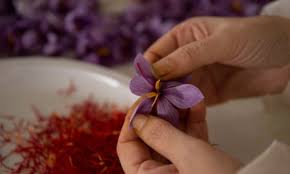Growers seek govt intervention, warn of possible extinction of saffron cultivation in Pampore by 2030 if no action taken
SRINAGAR: As saffron growers in the Pampore area of south Kashmir’s Pulwama district begin harvesting the world-famous spice, concerns are mounting over dwindling production despite timely rainfall this year.
Growers fear that if immediate steps are not taken, saffron cultivation in the region — known as the “saffron town of Kashmir” — may vanish completely within the next few years.
Growers told the news agency—Kashmir News Observer (KNO) that production had fallen drastically last season, with only 30 to 40 per cent yield compared to normal years.
They attributed this decline to multiple factors, including changing weather patterns, lack of irrigation facilities, land conversion, and the unavailability of healthy saffron corms.
Abdul Ashiq Hussain, a saffron grower from Pampore, said that although rainfall arrived on time this season, it failed to significantly improve crop output.
“Last year, the saffron corm didn’t grow properly due to a prolonged heatwave, and this year, despite rains, the plants didn’t recover as there was a prolonged dry spell this year as well. The situation is worsening each year,” he said.
He added that government interventions have remained mostly on paper. “There is a spice park in Dusoo Pampore and GI tagging for Kashmiri saffron, but what’s the use of such initiatives if production keeps falling? For the past 15 years, we’ve been hearing about the National Mission on Saffron, but on the ground, there are no functional irrigation facilities,” Hussain said.
Another grower, Ghulam Rasool, warned that if urgent measures aren’t taken, saffron cultivation in Pampore could disappear altogether by 2030. “Every year, production declines. The government must wake up from its deep slumber. Instead of indulging in blame games, there should be concrete steps to revive this heritage crop, which is the pride of Kashmir,” he said.
Growers said that the main obstacles facing the industry are the lack of irrigation infrastructure, the conversion of saffron fields into residential or commercial land, and the shortage of quality corms.
This year also on a large portion of saffron land, people have sown mustard and other crops as they are fed up with saffron cultivation now, they added.
“Many farmers have now started cultivating mustard or shifted to horticulture due to consistent losses in saffron,” said another farmer from the Lethpora area. “If this trend continues, Pampore’s saffron legacy will be just a memory.”
The growers have appealed to Chief Minister Omar Abdullah and the Agriculture Minister to address the crisis. They demanded restoration of traditional irrigation channels, regular monitoring of saffron fields, and measures to prevent illegal corm extraction.
Official records reveal a consistent decline in saffron production over the past two decades. The area under saffron cultivation shrank from 5,707 hectares in 1996–97 to just 2,387 hectares in 2019–2020, marking a 65 per cent drop.
Government data shows that production fell from 17.33 metric tonnes in 2021 to 14.87 MT in 2022, and marginally rose to 14.94 MT in 2023. However, last year’s output has been reported to be only around 30 per cent of normal production. Growers expect similar production this year.
They said that due to repeated prolonged spells, corms have not grown well in the last few years, and there is a need for quality saffron corms to revive this crop.
While the National Mission on Saffron (NMS) has revived some fields through sprinkler irrigation systems and farmer awareness programs, experts caution that the impact remains limited. “The siphoning off of corms and poor land management practices continue to negate the gains achieved under the mission,” said an agricultural scientist from SKUAST-K.
Pampore’s saffron, known for its rich colour and aroma, has been a symbol of Kashmir’s cultural and economic identity for centuries. However, with a changing climate, inadequate policy implementation, and shrinking cultivation areas, the livelihood of thousands of families dependent on this crop is at stake.
“Revival of saffron isn’t just about saving a crop — it’s about preserving a tradition, a culture, and an identity,” said a group of worried growers. “If immediate and effective measures aren’t taken now, by 2030, there may be no saffron left in Pampore.”


